
The Interborough Rapid Transit Company (IRT) was the private operator of New York City's original underground subway line that opened in 1904, as well as earlier elevated railways and additional rapid transit lines in New York City. The IRT was purchased by the city on June 12, 1940, along with the younger BMT and IND systems, to form the modern New York City Subway. The former IRT lines are now the A Division or IRT Division of the Subway.
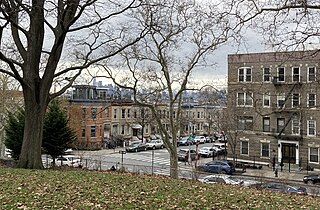
Sunset Park is a neighborhood in the western part of the New York City borough of Brooklyn, bounded by Park Slope and Green-Wood Cemetery to the north, Borough Park to the east, Bay Ridge to the south, and New York Harbor to the west. The neighborhood is named for a public park of the same name that covers 24.5 acres (9.9 ha) between Fifth and Seventh Avenues from 41st to 44th Street. The area north of 36th Street is alternatively known as Greenwood Heights, while the section north of 20th Street is also called South Slope.

The Bowling Green station is a station on the IRT Lexington Avenue Line of the New York City Subway, located at Broadway and Battery Place, in the Financial District of Manhattan. It is served by the 4 train at all times and the 5 train at all times except late nights.
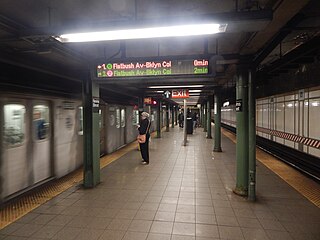
The Nevins Street station is an express station on the IRT Eastern Parkway Line of the New York City Subway. Located at the intersection of Nevins Street, Flatbush Avenue, and Fulton Street in Downtown Brooklyn, it is served by the 2 and 4 trains at all times, the 3 train all times except late nights, and the 5 train on weekdays only.

The Nostrand Avenue station is a local station on the IRT Eastern Parkway Line of the New York City Subway. Located at the intersection of Nostrand Avenue and Eastern Parkway in Crown Heights, Brooklyn, it is served by the 3 train at all times except late nights and the 4 train during late nights. There is also limited rush hour 2 and 5 services here.
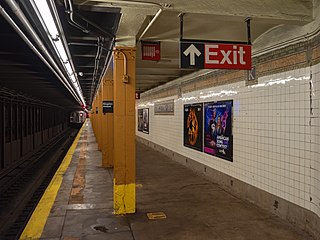
The Kingston Avenue station is a local station on the IRT Eastern Parkway Line of the New York City Subway. Located at the intersection of Kingston Avenue and Eastern Parkway in Crown Heights, Brooklyn, it is served by the 3 train at all times except late nights and the 4 train during late nights. There is also limited rush hour 2 and 5 service here.

A letter box, letterbox, letter plate, letter hole, mail slot or mailbox is a receptacle for receiving incoming mail at a private residence or business. For outgoing mail, post boxes are often used for depositing the mail for collection, although some letter boxes are also capable of holding outgoing mail for a carrier to pick up. Letterboxes or mailboxes use the following primary designs:
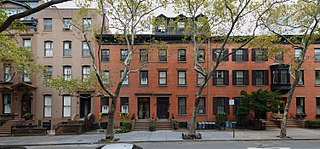
Brooklyn Heights is a residential neighborhood within the New York City borough of Brooklyn. The neighborhood is bounded by Old Fulton Street near the Brooklyn Bridge on the north, Cadman Plaza West on the east, Atlantic Avenue on the south, and the Brooklyn–Queens Expressway or the East River on the west. Adjacent neighborhoods are Dumbo to the north, Downtown Brooklyn to the east, and Cobble Hill and Boerum Hill to the south.

Fulton Street is a long east–west street in northern Brooklyn, New York City. This street begins at the intersection of Adams Street and Joralemon Street in Brooklyn Heights, and runs eastward to East New York and Cypress Hills. At the border with Queens, Fulton Street becomes 91st Avenue, which ends at 84th Street in Woodhaven.

Downtown Brooklyn is the third largest central business district in New York City, and is located in the northwestern section of the borough of Brooklyn. The neighborhood is known for its office and residential buildings, such as the Williamsburgh Savings Bank Tower and the MetroTech Center office complex.

The Borough Hall/Court Street station is an underground New York City Subway station complex in Brooklyn shared by the BMT Fourth Avenue Line, the IRT Broadway–Seventh Avenue Line and the IRT Eastern Parkway Line. The complex comprises three stations: Borough Hall on the IRT lines and Court Street on the BMT line. The stations are located under Court, Joralemon, and Montague Streets, next to Brooklyn Borough Hall, in the Downtown Brooklyn and Brooklyn Heights neighborhoods of Brooklyn. It is served by the 2, 4, and R trains at all times; the 3 train all times except late nights; the 5 train on weekdays; the N train during late nights; and limited rush-hour W trains.
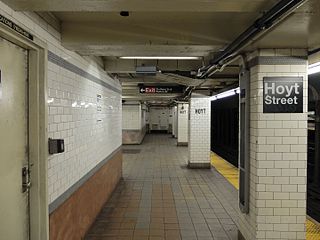
The Hoyt Street station is a local station on the IRT Eastern Parkway Line of the New York City Subway in Downtown Brooklyn. Located under the intersection of Fulton Street, Hoyt Street, and Bridge Street, the station is served by the 2 train at all times and the 3 train at all times except late nights.
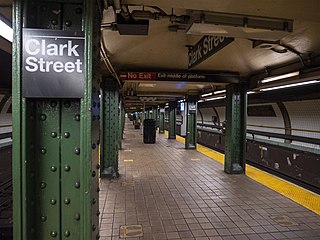
The Clark Street station is a station on the IRT Broadway–Seventh Avenue Line of the New York City Subway. It is located at Clark Street and Henry Street in Brooklyn Heights, Brooklyn. It is served by the 2 train at all times and the 3 train at all times except late nights. At approximately 80 feet (24 m) deep, the Clark Street station contains one island platform and two tracks. Its only exit is via a set of three elevators, which lead from a passageway above the platform to the ground story of the Hotel St. George. Despite being one of three New York City Subway stations that can only be accessed by elevators, the Clark Street station is not wheelchair-accessible with only stairs leading to the platforms.

The Joralemon Street Tunnel, originally the Brooklyn–Battery Tunnel, is a pair of tubes carrying the IRT Lexington Avenue Line of the New York City Subway under the East River between Bowling Green Park in Manhattan and Brooklyn Heights in Brooklyn, New York City. The Joralemon Street Tunnel was an extension of the Interborough Rapid Transit Company (IRT)'s first subway line from the Bowling Green station in Manhattan to the IRT Eastern Parkway Line in Brooklyn.

The Atlantic Avenue–Barclays Center station is a New York City Subway station complex shared by the BMT Fourth Avenue Line, the BMT Brighton Line and the IRT Eastern Parkway Line. Named after Atlantic Avenue and the Barclays Center arena, it is located at Fourth and Flatbush Avenues' intersections with Atlantic Avenue and Pacific Street in Downtown Brooklyn. The complex is served by the 2, 4, D, N, Q and R trains at all times; the 3 train at all times except late nights; the 5 and B trains on weekdays during the day; and a few rush-hour W trains.

Teunis Garret Bergen was an American farmer and politician who served one term as a United States representative from New York from 1865 to 1867.
Hans Hansen Bergen was one of the earliest settlers of the Dutch colony of New Amsterdam, and one of the few from Scandinavia. He was a native of Bergen, Norway. Hans Hansen Bergen was a shipwright who served as overseer of an early tobacco plantation on Manhattan Island, before eventually removing to Brooklyn's Wallabout Bay, where he was one of the earliest settlers and founded a prominent Brooklyn clan.
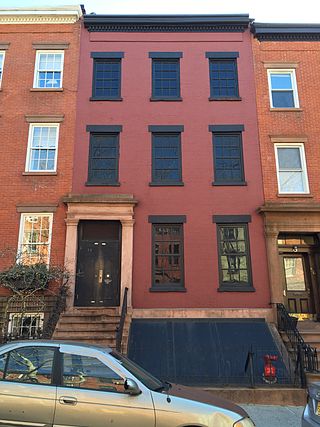
58 Joralemon Street, in Brooklyn Heights, Brooklyn, New York, United States, is a Greek Revival structure built in 1847 as a private residence but is now a New York City Subway vent. The Interborough Rapid Transit Company acquired the property in 1907, gutted the interior, and converted the structure to "the world’s only Greek Revival subway ventilator". The ventilator also serves as an emergency exit from the eastern end of the New York City Subway's Joralemon Street Tunnel, which carries the IRT Lexington Avenue Line between Bowling Green and Borough Hall, where it becomes the IRT Eastern Parkway Line.
The IRT Eastern Parkway Line is one of the lines of the A Division of the New York City Subway. Built for the Interborough Rapid Transit Company (IRT), it stretches from Downtown Brooklyn south along Flatbush Avenue and east along Eastern Parkway to Crown Heights. After passing Utica Avenue, the line rises onto an elevated structure and becomes the New Lots Line to the end at New Lots Avenue in East New York, Brooklyn. The west end of the Eastern Parkway Line is at the Joralemon Street Tunnel under the East River.
Stolk or Van Stolk is a Dutch toponymic surname. Stolk is a contracted form of Stolwijk, a town in South Holland.

















